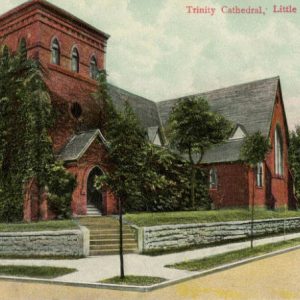calsfoundation@cals.org
Trinity Episcopal Cathedral
Trinity Episcopal Cathedral, located at 310 West 17th Street in Little Rock (Pulaski County), is a parish church and the seat of the bishop of the Episcopal Diocese of Arkansas. It was added to the National Register of Historic Places in 1976.
From the arrival of the first bishop in 1839 until late 1884, the Episcopal Diocese of Arkansas operated without a cathedral. On October 19, 1884, Trinity Episcopal Cathedral was formally established and held its first services.
Designed in English Gothic Revival style, Trinity Episcopal Cathedral is a common-bond brick structure with the main section in the shape of a cruciform. The interior is primarily darkly stained pine, punctuated with numerous stained-glass windows and motifs representing the trinity, including trefoils, fleurs-de-lis, and clover leaves. Along the west elevation, a spherical baptistry is present on the south corner, while an engaged tower extends on the north corner. Buttressed masonry walls enhance the band-saw Gothic design.
The establishment and construction of Trinity Episcopal Cathedral was largely due to the efforts of Henry Niles Pierce, elected as the fourth Missionary Bishop of Arkansas and the Indian Territory in 1870. After nine years in the position, Pierce recognized the need for a cathedral in Little Rock, an idea first made public in June 1879 during his address to the Diocesan Council. When Christ Church declined cathedral responsibilities, Pierce began raising money for construction of a new building, making his first collection on October 19, 1879, at St. Luke’s Church in Brooklyn, New York. By 1882, he had enough money to purchase the land at the corner of 17th and Spring streets. Pierce’s son, the Reverend Abraham Wallace Pierce, drew up plans for the cathedral, while construction was supervised by master builder Ambrose Pettifer.
Built in stages as funds were available, the nave, baptistery, and tower were opened on October 19, 1884, Pierce’s birthday. During early services, the altar was placed under the west window as a temporary chancel. The crossing and transepts were added by February 1889, and by Easter 1892, the chancel was finished and the altar was moved to the east end of the building. Electricity was installed in 1895, and the choir room at the northeast corner of the nave and transept was converted in 1924 into a chapel, given by Elizabeth Pierce Lyman in memory of her father, Bishop Henry Niles Pierce.
Other memorials and gifts have been presented over the years, the first of which was the brass altar cross in memory of Halfden Degen, the first acolyte, who died in 1886 of typhoid fever. The window over the altar, a memorial to Bishop Pierce, was dedicated Easter 1909, while the carved eagle lectern was given in memory of Edmond Urquhart in 1918. In 1924, the altar and reredos, carved in Oberammergau, Germany, were placed in memory of Blakeslee and Philander Keep Roots.
The Parish House and Cathedral House were built in 1951 and 1953, respectively. In 1981, Chancellors Hall was built, and both houses were renovated. In 1998, the sanctuary was closed on Easter Sunday to begin nearly $5 million in renovations to the cathedral, Parish House, and diocesan offices, as well as the addition of Dean’s Hall, connecting Morrison Hall to the cathedral. The “year in exile,” during which all services were held in the cathedral’s gymnasium and Chancellors Hall, ended on Christmas Eve.
The cathedral installed a new pipe organ, designed by Trinity organist and choirmaster James R. Metzler and manufactured by Mull Pipe Organ Company, in 1999. The organ is the largest instrument of its kind in Arkansas.
Recognized for its architectural and historical significance, the cathedral was added to the National Register of Historic Places on May 13, 1976. The cathedral was one of the local settings for the movies God’s Not Dead 2 (2016) and God’s Not Dead: A Light in Darkness (2018). By 2018, Trinity had more than 1,200 registered members. In early 2024, a portable pipe organ, containing 239 pipes and cased in white oak, was dedicated at Trinity.
For additional information:
Lockwood, Frank E. “Movable Masterpiece.” Arkansas Democrat-Gazette, March 2, 2024, pp. 4B, 5B. Online at https://www.arkansasonline.com/news/2024/mar/02/organ-dedicated-at-trinity-episcopal-cathedral-in/ (accessed March 4, 2024).
Lyman, Elizabeth Pierce. “History of Trinity Cathedral.” Unpublished brochure, 1934.
Trinity Episcopal Cathedral.https://www.trinitylittlerock.org/ (accessed November 2, 2018).
“Trinity Episcopal Cathedral.” National Register of Historic Places registration form. On file at Arkansas Historic Preservation Program, Little Rock, Arkansas. Online at http://www.arkansaspreservation.com/National-Register-Listings/PDF/PU1264.nr.pdf (accessed November 2, 2018).
Worthen, Mary Fletcher. The History of Trinity: The Cathedral of the Episcopal Diocese of Arkansas, Little Rock, 1884–1995. Little Rock: August House, 1996.
Sarah Bost
UA Little Rock Center for Arkansas History and Culture
 Historic Preservation
Historic Preservation Post-Reconstruction through the Gilded Age, 1875 through 1900
Post-Reconstruction through the Gilded Age, 1875 through 1900 Trinity Episcopal Cathedral
Trinity Episcopal Cathedral 




Comments
No comments on this entry yet.